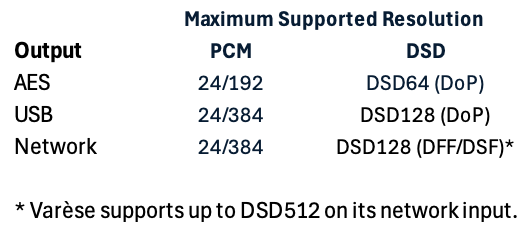There have been a couple of threads on this topic recently and forum members may have seen the recent reviews of the Antipodes Oladra in Hifi+ Magazine and the Innuos Nazaré in Stereophile, both of which mention connection to dCS products. In this post we will try to lay out the pros and cons of different streaming configurations for dCS products and how external streamers should be set up for optimum format support, clocking systems (which have a major influence on sound quality) and user experience when used in conjunction with dCS products. All current dCS systems contain a network streamer – most contain it in the same chassis as the DAC, but in others like Vivaldi or Varèse it is a separate unit. For the sake of clarity, I will therefore refer to streaming-enabled dCS products as “dCS devices”.
Format Support
dCS devices all offer a variety of different connections for their digital inputs. These can be broken down into two categories, Synchronous (S/PDIF and AES) and Asynchronous (USB and Network). The common Synchronous interfaces are all limited in bandwidth compared to their Asynchronous counterparts. S/PDIF and AES are both supported up to 24/192 PCM or DSD64** whereas USB and Network connections can both support higher bandwidths enabling broader format support (see chart below). Note that only the Network input can support native DSD files (DFF/DSF format) whereas S/PDIF, AES and USB require DSD to be encoded as DoP which requires support at both the server and the DAC ends (most but not all third-party streamers support DoP on their USB outputs). DoP results in identical sound quality to “native” DSD as the data converted by the DAC is identical.
** Current dCS systems support dual AES which raises the limit to 24/384 or DSD128 but very few third-party streamers support this.
So, for the broadest format support we recommend using the network interface on dCS devices.
Clocking
dCS DACs support three clocking regimes:
- Word Clock Input (W) where the clock in the DAC (plus a synchronous source if it has a suitable word clock input) is slaved to an external Master Clock which “manages” or “steers” the clock in the DAC to ensure the two remain in sync as well as reducing jitter.
- Master Clock (M) where the clock in the DAC is the master.
- Audio Clock (A) where the master clock is embedded in and extracted from the audio stream.
These are in descending order of preference, with 1 offering the best jitter performance and sound quality, and 3 the worst. For more detail on clocking please see our website.
It is important to note that external sources such as Disc Transports or Servers connected with synchronous connections (S/PDIF or AES) must offer a word clock input to be compatible with 1 or 2 and most third-party streamer products do not.
So, from a clocking/sound quality perspective we recommend using Asynchronous interfaces, USB or network.
User Experience
This covers several areas, some of which are highly subjective and some less so.
Streaming Services
dCS devices all contain a streaming board which supports a wide variety of streaming services/protocols:
Note that apart from Airplay (which is limited to 24/48) all these services use the same underlying network mechanisms to transport audio to the dCS device so any differences in sound quality are due to factors other than the service/protocol used (for instance different masters/versions or the application of some additional DSP).
Local Storage
All dCS devices also support UPnP, a widely adopted standard that allows the playback of files stored on the local network (either ripped from disc or downloaded). UPnP is supported by many popular client apps such as Audirvāna and JPLAY as well as dCS Mosaic and dCS Mosaic ACTUS. To play locally stored files all that is required in addition to the dCS device is some local storage, such as a laptop or NAS, and a UPnP server that has access to the files stored there. We recommend MinimServer as that is the one we test against, but any standard-compliant UPnP server should work.
Network vs USB
When using connection methods other than network with a third-party streamer the streamer determines which services/protocols and which client apps are supported. This is naturally a subjective choice, however the dCS device still needs to be connected to the network to receive firmware updates and allow settings to be controlled from the Mosaic app, so if it supports the user’s preferred streaming service and client app the network connection offers a convenience advantage.
When used with a Varèse the principal difference in the user experience between the USB input and the network input is that the former bypasses most of the functionality of the Varèse UI for displaying track metadata, album art etc. However, there are other minor differences in the user experience between USB and network connections with all dCS devices. For instance, when using the network interface the dCS device is aware of upcoming sample rate changes and can pause the audio until the DAC has completed the switch to the new sample rate (we mute and unmute the output to avoid loud pops during sample rate changes). With a USB connection the DAC only finds out about the sample rate as it changes and is unable to pause the audio until it is ready, which may result in the beginning of the track being cut.
So, from a user experience perspective we recommend the network interface.
Summary
In summary, for broadest format support with no dependencies on protocol support in the server, best sound quality through compatibility with the lowest jitter clocking regimes, and the best user experience across the dCS range, we recommend the network interface for connecting to third party servers. For those that do not support a network connection to the DAC we would recommend USB as the best alternative.
We will be following up this post with recommended configurations for a number of third-party streamers.

